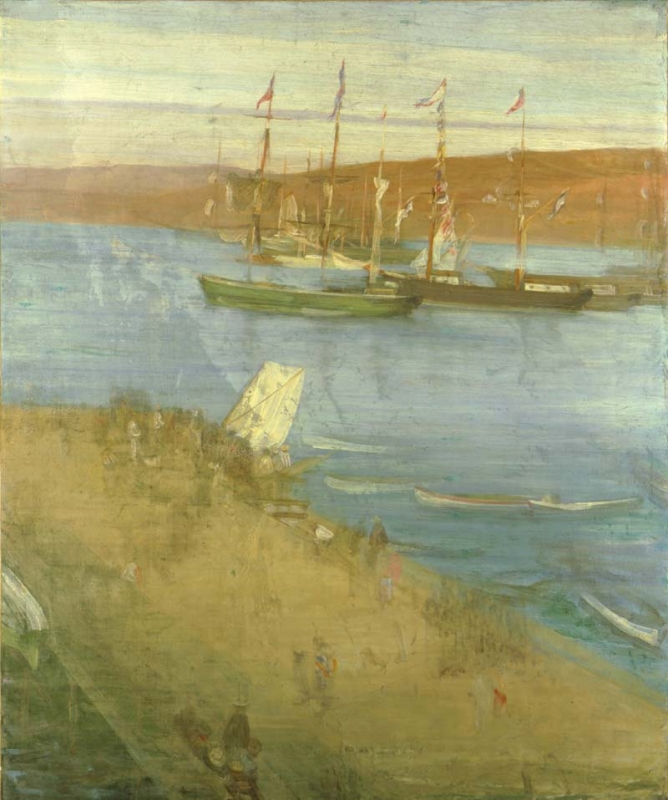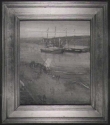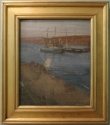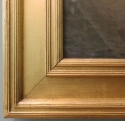Home > Catalogue > Browse > The Morning after the Revolution, Valparaiso << >>
Composition
The Morning after the Revolution, Valparaiso is closely related to Sketch for 'Nocturne in Blue and Gold: Valparaiso Bay' [YMSM 074], which has a similar lighting effect. The Morning after the Revolution, Valparaiso, however, has two additional ships in the background, and small boats by the pier.
The final version of the subject appears to be Nocturne in Blue and Gold: Valparaiso Bay [YMSM 076], which is, as the title suggests, a night scene, and includes even more ships and figures, but no sailing boat by the pier or small boats in the bay.
The high viewpoint could be considered an early example of the influence of Japanese woodcuts on the composition, but is actually more likely to be the result of Whistler literally painting from a high viewpoint.
Technique
The canvas is a fairly fine tightly woven fabric, lined with a similar material. The structure is confusing, with a lumpy surface that may be the result of a layer of priming used to partly cover an earlier painting, or earlier version of the same subject. The final painting is thinly painted over this lumpy surface. 1
The priming is conventional: a layer of lead white and chalk in oil, applied over a more chalk-rich layer. There is a very thin, artist-applied pink/mushroom imprimatura made from natural red ochre and bone black. Lead white, bone black, vermilion, yellow ochre, brown ochre, madder, cobalt blue, and natural ultramarine were used. 2
There are extensive signs of alterations in The Morning after the Revolution, Valparaiso. There was some damage and repainting in the upper left corner and on parts of the pier. The central ship was originally heeling more to the left, with both masts further left. The ship at upper right has been almost eliminated, the sea being painted over it. Under-drawing was used for the hulls of the large masted ships. There appear to have been changes in the number and grouping of figures on the pier. The pier was originally slimmer on both sides, and it was drawn in some detail, as were most of the figures on it. Its left side was painted over water, but is not fully resolved.
In 1874 Whistler apparently considered at least one of his Valparaiso paintings unfinished, mentioning the possible sale of 'the Valparaiso piece if I ever finish it'. 3 This could refer to The Morning after the Revolution, Valparaiso but it is more likely to refer to Nocturne in Blue and Gold: Valparaiso Bay [YMSM 076], which also shows signs of extensive reworking.
The Morning after the Revolution, Valparaiso is a bright, bold, and vivid painting, a bridge between the realism of earlier sea- and river-scapes, such as Grey and Silver: Chelsea Wharf [YMSM 054] and Crepuscule in Opal: Trouville [YMSM 067], and later nocturnes, particularly Nocturne in Blue and Gold: Valparaiso Bay [YMSM 076].
Conservation History
There is extensive evidence of damage down the centre of the canvas, arising from old creases, folds or even tears, which have been repaired and secured by lining the canvas at some time. The lining is an unusual bleached linen.
Although the painting is structurally sound, there are signs of damage, paint loss, and uneven paint staining, which may be the result of the under-layer of paint and priming, and there are some areas of surface cracking and bubbling. 4 It has had a hard life!
Frame
Flat Whistler frame, which could date from the late 1860s or 1870s. However, since the painting was never exhibited, it may have been a frame that was in Whistler's studio, and not actually intended for this painting. 108.5 x 95.1 x 4.0 cm.
Notes:
1: Conservation report by Clare Meredith, 14 May 2001, Hunterian files.
2: Technically, the madder is technically, madder on an Al-based substrate. Technical analysis carried out at the Natural History Museum EM Unit, London, for Professor Joyce H. Townsend. Examination report by Prof. Townsend, Tate Britain, 2017. She adds that there is no evidence that Whistler used a medium modifier, but some reticulated areas of the surface suggest that the thinner evaporated too fast, possibly due to high temperatures encountered in Chile.
3: Whistler to A. Chapman, 22 June 1874, GUW #11251.
4: Conservation report by Clare Meredith, 14 May 2001, Hunterian files.
Last updated: 20th October 2020 by Margaret











